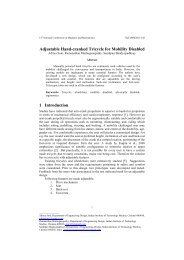Shortest path in a multiply-connected domain having curved ...
Shortest path in a multiply-connected domain having curved ...
Shortest path in a multiply-connected domain having curved ...
Create successful ePaper yourself
Turn your PDF publications into a flip-book with our unique Google optimized e-Paper software.
compute the tangency po<strong>in</strong>ts to use an algorithm like Dijkstra, which will be of O(T 2 ), the<br />
complexity of our algorithm is O(T ). Also, it is worth not<strong>in</strong>g that the algorithm directly<br />
computes all the potential <strong>path</strong> on the fly.<br />
6 Conclusion<br />
In this paper, an algorithm to compute SIP of <strong>curved</strong> boundaries, form<strong>in</strong>g a <strong>multiply</strong><strong>connected</strong><br />
doma<strong>in</strong>, extend<strong>in</strong>g the algorithm <strong>in</strong> [18] has been presented. It is shown that all<br />
potential <strong>path</strong>s can be computed, elim<strong>in</strong>at<strong>in</strong>g many PCTs/BTs/<strong>in</strong>ner loops us<strong>in</strong>g a generalized<br />
region lemma and then specifically f<strong>in</strong>d<strong>in</strong>g exterior and <strong>in</strong>terior regions us<strong>in</strong>g PCTs/BTs.<br />
Merg<strong>in</strong>g of <strong>path</strong>s that will avoid redundant computation is also done. It is also shown that the<br />
algorithm can be applied to any number of holes and also to curves hav<strong>in</strong>g C 1 discont<strong>in</strong>uity<br />
po<strong>in</strong>ts. Test results on a few cases <strong>in</strong>dicate that the algorithm is very amenable to implementation.<br />
SIP can be computed without employ<strong>in</strong>g visibility graph and Dijkstra. Further work<br />
<strong>in</strong>volves focuss<strong>in</strong>g on applications based on [18] and this paper.<br />
References<br />
[1] Alfred V. Aho, John E. Hopcroft, and Jeffrey D. Ullman. Data Structures and Algorithms.<br />
Addison-Wesley, 1983.<br />
[2] H. Alt and E. Welzl. Visibility graphs and obstacle-avoid<strong>in</strong>g shortest <strong>path</strong>s. Mathematical<br />
Methods of Operations Research, 32:145–164, 1988. 10.1007/BF01928918.<br />
[3] Richard D. Bourg<strong>in</strong> and Sally E. Howe. <strong>Shortest</strong> curves <strong>in</strong> planar regions with <strong>curved</strong><br />
boundary. Theoretical Computer Science, 112(2):215 – 253, 1993.<br />
[4] Ee-Chien Chang, Sung Woo Choi, DoYong Kwon, Hyungju Park, and Chee K. Yap.<br />
<strong>Shortest</strong> <strong>path</strong> amidst disc obstacles is computable. In Proceed<strong>in</strong>gs of the twenty-first<br />
annual symposium on Computational geometry, SCG ’05, pages 116–125, New York,<br />
NY, USA, 2005. ACM.<br />
[5] Danny Z. Chen and Haitao Wang. Comput<strong>in</strong>g shortest <strong>path</strong>s amid pseudodisks. In Proceed<strong>in</strong>gs<br />
of the Twenty-Second Annual ACM-SIAM Symposium on Discrete Algorithms,<br />
SODA ’11, pages 309–326. SIAM, 2011.<br />
[6] Danny Z. Chen and Haitao Wang. A nearly optimal algorithm for f<strong>in</strong>d<strong>in</strong>g L1-shortest<br />
<strong>path</strong>s among polygonal obstacles <strong>in</strong> the plane. In Proceed<strong>in</strong>gs of the 19th European<br />
conference on Algorithms, ESA’11, pages 481–492, Berl<strong>in</strong>, Heidelberg, 2011. Spr<strong>in</strong>ger-<br />
Verlag.<br />
[7] David P. Dobk<strong>in</strong> and Diane L. Souva<strong>in</strong>e. Computational geometry <strong>in</strong> a <strong>curved</strong> world.<br />
Algorithmica, 5(1-4):421–457, 1988.<br />
[8] Gershon Elber. IRIT 10.0 User’s Manual. The Technion—IIT, Haifa, Israel, 2009.<br />
16




